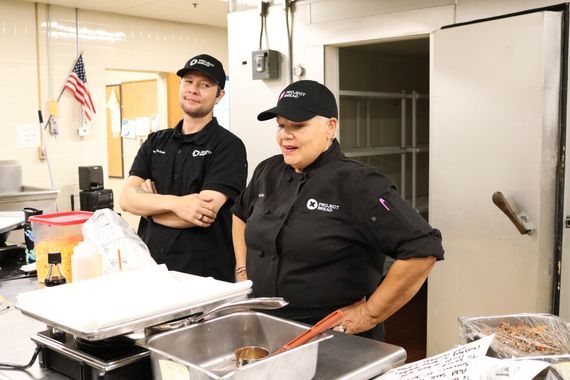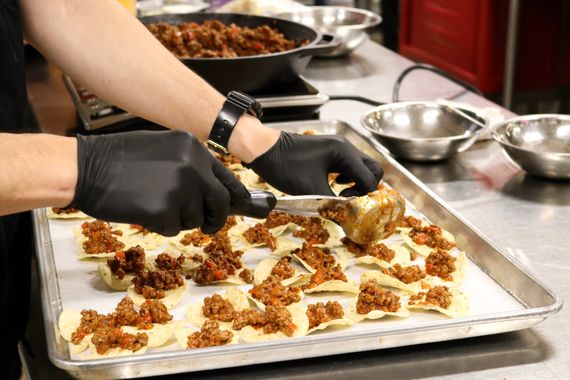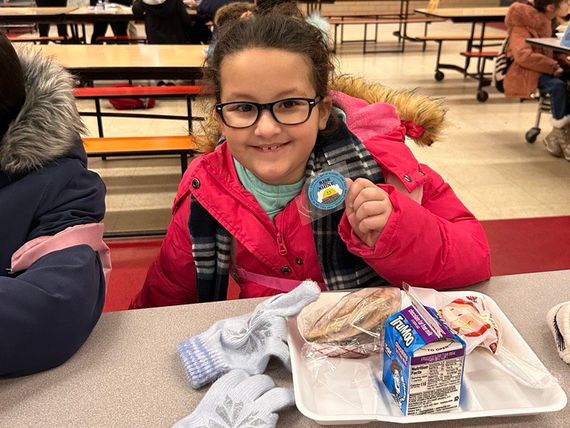Back to School: How Students Benefit From Free, Healthy School Meals
Project Bread

Henry J. Robinson Middle School in Lowell buzzed with excitement on a Friday morning, as school nutrition staff across eastern Massachusetts sampled a Project Bread school recipe — Bartlett’s Boomin’ Nachos — made by our chef educators Ryan Eckles and Sherry Hughes in collaboration with Wally Robles, cook manager at Bartlett Community Partnership School.
Some folks have been working in schools for less than a year. Others, close to 20. Regardless of experience, school nutrition professionals play one of the most important roles in ending child hunger: feeding kids in school and feeding them well.
“Growing up, you only had one option [for] meals. Now you're introducing a variety, then you have tasting and all that, everything that restaurants provide on a daily basis. Now we're bringing it to the school. And I love it,” said Wally.
For many kids, the school year starting means breakfast and lunch returning, two substantial meals that they can rely on at school to fuel them throughout the day. In fact, School Meals for All increases access to free school meals for up to 400,000 students.
We’ll cover:
-
How schools feed kids
-
Why we need healthy school meals for all
-
Benefits of eating school meals
-
Back to school meals: getting kids to eat
How Schools Feed Kids
Picture this: you’re in middle school. It’s 10 am, and you have a long day ahead. Sitting at your desk hangry with your focus waning, you await lunch, knowing it’ll give you the fuel to carry you through the day.
Schools are a critical access point for feeding kids. A lot of kids. As kids spend about 24 percent of their time at school during any given week, school nutrition professionals significantly impact their health. In fact, these hardworking staff serve 857,077 meals daily to kids in Massachusetts and provide them with 40 to 70 percent of their weekly nutritional needs.

“There is not a single other job that we have in our society, other than maybe doctors or nurses, that have your type of impact on future generations, none,” Project Bread’s Chef Ryan addressed school nutrition professionals. “That means that the kids can't survive without coming here and eating the food. That's super important.”
This underscores just how critical school meal programs are in ensuring children receive the essential nutrients they need for healthy growth and development. By offering balanced and nutritious meals, schools contribute significantly to the overall well-being of their students and support their ability to learn and thrive.
At Project Bread, we work directly with schools, partnering with school nutrition staff to create nutritious and delicious school breakfast and lunch meals students love. It is a collaborative effort; to ensure students enjoy the meals, we invite staff and students to taste-test the recipes.

For example, with Project Bread's support, Wally developed the nachos recipe, inspired by the flavors of a classic Sloppy Joe.
“We work based on evidence. So we don’t just come into a district and say, ‘Oh, we’re gonna make this today and serve this.’ We taste-test it with you and we taste-test it with the students,” Project Bread's Chef Sherry said to a crowd of school nutrition professionals during the Lowell training session.
Why We Need Healthy School Meals for All
In August 2023, Project Bread successfully led the Feed Kids Coalition and our partners in the legislation to make School Meals for All permanent in Massachusetts, ensuring students receive the nutrition they need for years to come. Our supporters and advocates played a vital role in this win, now resulting in 100,000 more kids eating school lunch daily.
All students need healthy school meals to thrive. Providing free school meals ensures that nutritious food is available to every child, easing the financial burden on families. Healthy school meals play a significant role in establishing good eating habits to prevent type 2 diabetes, heart disease, and obesity, costly chronic illnesses that can take a financial toll.
However, school meals aren't just about necessity — they can also be enjoyable and social. Sharing meals with peers helps kids build friendships and essential social skills. When students see their peers trying new foods in the cafeteria, they are more likely to follow suit, leading to increased consumption of nutritious foods that support their growth and development. It's incredible to see how a little healthy peer pressure can encourage kids to embrace vegetables and other nutritious foods.
Furthermore, families from diverse income backgrounds can benefit from school meals provided at no cost for all students. This initiative makes parents' lives easier, lessening the financial burden of grocery shopping to prepare school breakfast and lunch for kids.
Benefits of Eating School Meals
Did you know that eating school meals comes with a myriad of benefits? From saving time to breaking down barriers and stigma, there’s more than meets the eye when it comes to eating meals at school.
- Saves Time
Eating school meals comes with numerous benefits that extend beyond just providing nourishment. First and foremost, it saves time in the morning, ensuring that children can get out of bed and out the door without the added stress of preparing meals. Knowing that kids will eat in school simplifies the morning routine and ensures they start their day with a healthy and fulfilling meal.
- Saves Money
In addition to time saved, there are significant cost savings associated with school meals. On average, it can save a family around $1,200 per year per child. This reduction in expenses is coupled with an environmental benefit, resulting in using fewer plastic sandwich bags and taking up less space.
-
Breaks Down Barriers and Stigma
Additionally, by providing free meals to all students, school meal programs work to break down barriers and stigma associated with meal assistance. This inclusive approach means that more kids can enjoy breakfast and lunch together at school, fostering a sense of community and ensuring that everyone can participate in recess with the energy from a full stomach.
-
Boosts Revenue for Your Child's School Nutrition Program
Moreover, by participating in school meal programs, families contribute to boosting revenue for their child’s school. This additional funding is then reinvested to enhance the school meal program, leading to tastier and healthier meals for the students. This cycle of improvement ensures that students receive high-quality and nutritious meals, positively impacting their overall well-being.
Back to School Meals: Getting Kids to Eat
Making meals is one thing, but getting students to eat them is another. School nutrition professionals can increase student meal consumption with a few tips and tricks.
Devise creative recipes
Don’t be afraid to experiment in the kitchen. Creating fun dishes can make mealtime more appealing to kids.
“Just keep going. And don’t pass judgment after one failure,” advised Ryan. “That’s just a jumping off point for negotiations for the next iteration of that recipe. Well, what do we need to change?”

Put effort into presentation
Serving meals creatively, such as arranging food in playful shapes or using bright, colorful plates, can make the dining experience more enjoyable and enticing for kids.
“[If you have a] giant bowl of cheese and a giant bowl of chips, you're less inclined to build your own bite and eat it. That's just the reality of the situation. So the time and effort and labor that you put into making something look pretty is not a waste of time,” Ryan said
Craft culturally mindful meals
Incorporating diverse flavors and ingredients into the menu can introduce kids to new tastes and expand their culinary horizons, making mealtime an exciting cultural experience.


Get buy-in from staff and students
Involving students in the meal planning process and seeking feedback can help build a sense of ownership and enthusiasm for the meals while garnering support from staff members can create a positive dining environment for the kids.
Join us in our fight against hunger.
Support Our Work Feeding Kids
While we have accomplished a lot with securing permanent School Meals for All in Massachusetts, our work continues. We’re driven by impact and committed to ensuring future generations don't go hungry. Your gift today will mean more kids will start their school day with free breakfast, students will eat higher quality meals in school, and more eligible families will get help buying groceries through SNAP.